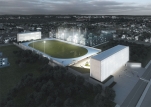Place for Sports and Socializing

The new UFCSPA Igara sports campus in Brazil is more than a public institution – it is a bold and green public space as well. This was the guiding principle behind the proposal designed by OSPA Arquitetura e Urbanismo, who created a two-faced plan for the Federal University of Health Sciences of Porto Alegre to have two levels of programmatically diverse spaces. This Brazilian building has an entire soccer field on its roof.
Sports in Brazil love all, and on the eve of the Olympic Games XXXI in Rio de Janeiro its popularity increased even more. It is no secret that the most popular and spectator sport is football. And how could it be any other way in the country where the national team five times became the winner of the World Cup, more than any other worldwide.
Football for Brazilians – is more than just a game, it is an integral part of their life and culture. It is no wonder that football is played everywhere, and, fortuitously, football arenas are really a lot there, as well as the playgrounds, on which started out many acclaimed players. And amongst them is Pele, universally recognized as the greatest player of the XX century, whose name is known even to those who are not interested in football at all.
The Maracana stadium in Rio de Janeiro, built in 1950, before the reconstruction was the largest in the world, and could accommodate 200,000 spectators. In Porto Alegre there is also a stadium – “Beira Rio” (1969), where five World Cup matches were held in 2014. There is a brand new – “Arena Gremio” (2012), and the historic one – “Estádio Olímpico Monumental” (1954).
In Brazil, traditionally great importance is attached to the development of school sports, where physical education classes are mandatory for all. But in the universities such a subject is not applicable, with the exception of the specialized universities, where not only read the theoretical courses in anatomy and physiology, but also practice.
Full content of this issue you can read here
The full version of the article can be read in our printed issue, also you can subscribe to the web-version of the magazine
 Materials provided by OSPA Arquitetura e Urbanismo
Materials provided by OSPA Arquitetura e Urbanismo


